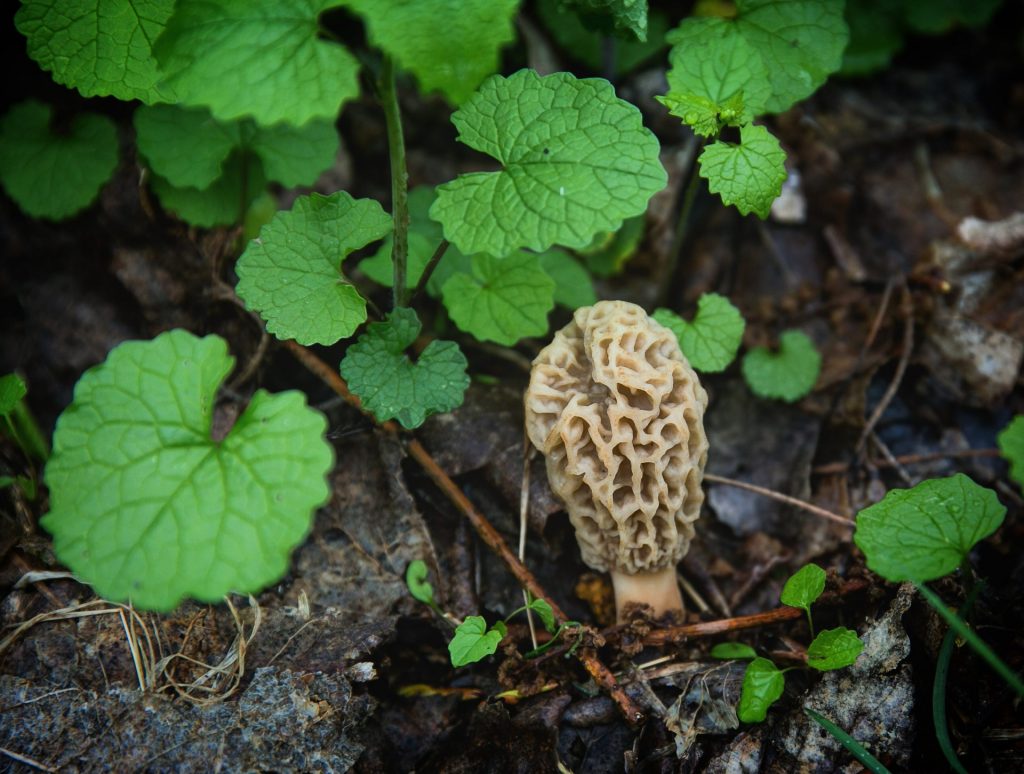
Story and photos by Jenny Nguyen-Wheatley
Morel mushroom hunters will know this plant: Garlic mustard (Alliaria petiolata), a biennial, is one of the first signs of green-up in Missouri River woodlands. This low-lying plant prefers moist soils, shade and limited sun, and while its heart-shaped leaves might look inviting during the bareness of early spring, garlic mustard is highly invasive. It outcompetes native plants and threatens the biodiversity of our woodland ecosystems.
Distribution
The story of how garlic mustard arrived to the New World is similar to that of other invasive plants. Early European settlers brought garlic mustard to North America primarily for food and medicine, and finding conditions exceedingly favorable, the species escaped from gardens, thrived and spread uncontrollably. Today, garlic mustard has spread over practically all of northeastern and midwestern United States. It has also made its way into Colorado, Utah and as far west as Oregon.
In Nebraska, garlic mustard is becoming an increasing concern and annoyance among land managers. It is well established in eastern Nebraska woodlands, and although infestations are concentrated along the Missouri River and its lower tributaries, biologists have detected populations as far west as Bassett on the Niobrara River, Kearney on the Platte River and Cambridge on the Republican River.
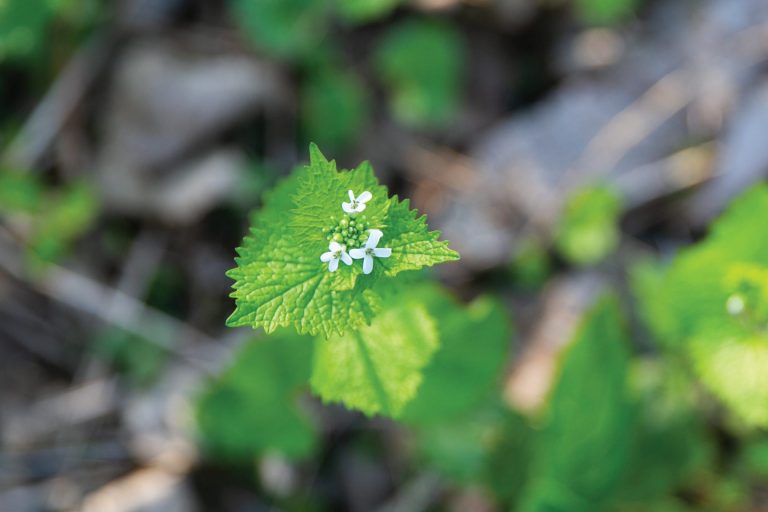
Mustard Advantage
“Garlic mustard is equipped with a special chemical called sinigrin, which it releases by its roots into the soil,” said Chance Brueggemann, a Northern Prairies Land Trust biologist. “Sinigrin is toxic to many native plants and their supporting mycorrhizal fungi.”
Chance and Krista Lang, another NPLT biologist, have been trying to control the infestation at Indian Cave State Park’s oak woodlands over several years.
When matured, one garlic mustard plant can produce thousands of seeds, which readily hitchhike on animals that brush up against it, hikers who get the seeds stuck on their shoes and clothes, or on the tires of vehicles that collect mud containing the seeds. According to Lang, garlic mustard can also spread via waterways. The infestation at Indian Cave appears to have originated from seed that washed down the Missouri River during floods, she said.
In addition to these advantages, garlic mustard has none of its natural “enemies” in North America, therefore no insects, fungi nor diseases to control its populations. Debby Kleinstein of Columbia University wrote that, in Europe where garlic mustard originated, more than 30 insects attack its leaves, stem and seeds; specialist herbivores also use garlic mustard as a food source.
The plant has few if any benefits to wildlife in North America. Brueggemann noted that while native pollinators might find garlic mustard useful in spring, flowers are gone by mid-June. Also, garlic mustard’s tendency to create monocultures outcompetes native plants, eliminating food sources that would otherwise benefit pollinators and other wildlife.
“This is why biodiversity is so important,” said Brueggemann. “Deer tend to nibble on garlic mustard once in a while, but we don’t see a significant amount of herbivory on it.”
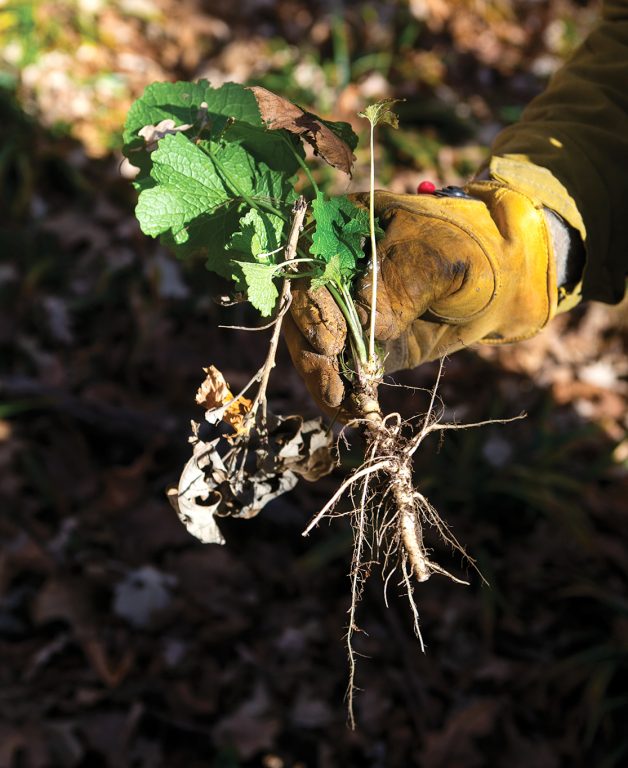
Methods of Control
Methods of controlling garlic mustard include herbicides, pulling mature plants by hand and the use of prescribed fires. Brueggemann urges land managers to limit herbicide treatment to fall or winter to lower the chances of overspray and killing nearby native plants, which have gone dormant. Plants pulled by hand should be hauled out and disposed where seeds can’t spread later on; better yet, make a pile and burn it onsite. Although pulling garlic mustard is time consuming, it ensures the removal of the seed source and avoids the use of harmful chemicals on the ecosystem.
NPLT biologist Chris Wood, who helps manage the infestation in northeastern Nebraska, said that a follow-up prescribed burn is imperative to controlling garlic mustard.
“Something I’ve noticed is that if you conduct a woodland burn in the fall and don’t follow up with a burn the following year, it seems to help garlic mustard spread even faster,” Wood said. “Basically, a fall burn will clean up the debris, release nutrients and create a perfect space for garlic mustard to grow. Burning two years in a row will help knock back some second-year growth by potentially killing plants and reducing seed production, in addition to killing seedlings, which will reduce an infestation over time.”
The best plans incorporate all three methods.
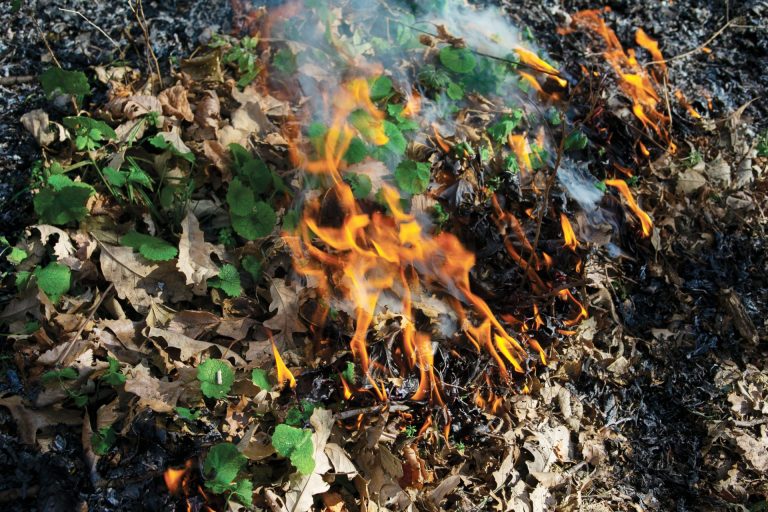
What Landowners Should Do
Once established, management of garlic mustard will be time consuming and ongoing. Early detection is key.
“It’s the ‘ounce-of-prevention-is-worth-a-pound-of-cure’ concept,” said Cassidy Wessel, a Game and Parks Commission biologist in Norfolk. “As some invasive species become established, they create a positive feedback loop, altering soil chemical properties through allelopathic traits, building up a seed bank and so on. The longer you wait, the tougher it gets to control it.”
Allelopathy is when an organism produces one or more biochemicals that are released through its roots into the soil, making growing conditions less tolerable for other species. It’s a strategy some plants use to outcompete others, and in the case of garlic mustard, that is the chemical sinigrin mentioned previously.
If a landowner detects garlic mustard on his or her property, Brueggemann recommends taking the following steps.
Step 1: Determine the area of the infestation. “Usually by the time a landowner notices an infestation of invasive plants, the population size is often larger than one thinks,” he said.
Step 2: Begin control on the smaller, outlying populations of the infestation and then work inward toward the areas of higher densities.
Step 3: Revisit the area annually and continue controlling the plants.
“Similar to other invasive or exotic species, once garlic mustard is well established it will be hard to eradicate,” Wood said. “However, through the various control methods mentioned, it could be managed to the point where it’s not damaging woodland ecosystems.”
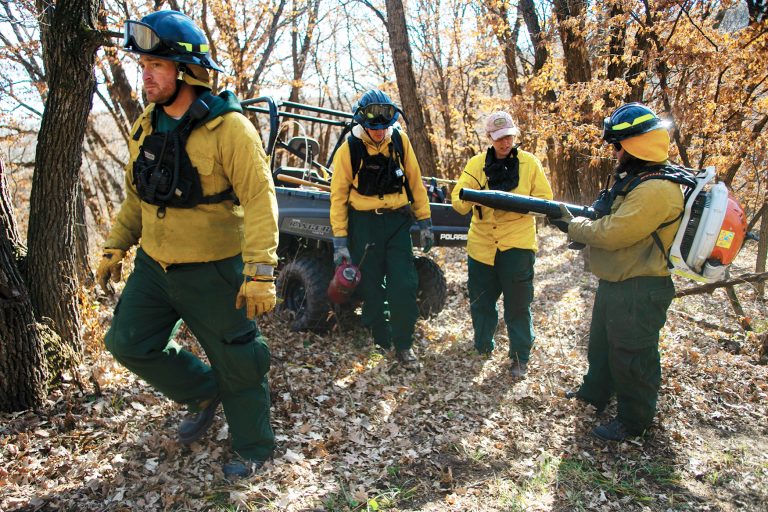
Studies
Debate exists among experts on the necessity of controlling garlic mustard. Lang referenced a handful of land managers who have stopped actively controlling garlic mustard by pulling and spraying, and are only employing prescribed fires as a part of larger habitat goals to limit its density.
“Some sources back East, where garlic mustard has been established for much longer, suggest that infestations go through a period of growing in dense patches but then begin to thin out with time,” Lang said. “Some say garlic mustard becomes ‘naturalized’ rather than ‘invasive’ after a while, perhaps a decade or so. If garlic mustard does indeed thin out and allow space for native plants to once again grow in some reasonable level of plant diversity, then it is not a huge problem.”
However, land managers, including Lang, are hesitant to accept this observation as fact. It is unknown if the plant will do that in our region.
“It is really hard to just let things go and hope that things turn out OK,” Lang said.
Studies on controlling garlic mustard are continually evolving, including a potential bio-control method. Canada has been testing several insect species with the hopes of combatting garlic mustard with a natural predator introduced from Europe. Agriculture and Agri-Food Canada has identified the root mining weevil (Ceutorhynchus scrobicollis) as most promising.

In August and December 2018, the Centre for Agriculture and Bioscience International released C. scrobicollis into the Canadian wilderness under close monitoring. Before release, CABI in Switzerland conducted years of safety testing, including under quarantine conditions at the University of Minnesota, to demonstrate that the species would effectively target garlic mustard without negatively affecting native species.
“If the project is successful, it could be a very important addition to helping us manage garlic mustard infestations,” Wood said.
For the time being, Nebraska land managers remain vigilant.
Wild Garlic Mustard Pesto
Garlic mustard (Alliaria petiolata) is a biennial flowering plant that can outcompete native species and quickly take over forest floors. While common methods to control garlic mustard include burning, pulling and spraying, few Americans actually eat it. The whole plant is edible, and historically, garlic mustard is one of the oldest herbs and spices used by humans in Europe.
Crush the leaves between your fingers and you will smell the familiar aroma of its namesake – garlic; and like mustard, its taste is mildly peppery and spicy, a nice alternative to common store-bought greens such as mustard greens, arugula or watercress. Harvest garlic mustard in the spring when leaves are still young and mild. Once warm weather arrives, leaves will become bitter.
Use garlic mustard in a variety of dishes, and eat it raw or cooked. A few ideas include adding garlic mustard into a salad mix, substituting lettuce in wraps and sandwiches or use it in place of spinach in your favorite egg dishes. Lightly sauté the leaves and stems with olive oil or butter for a side dish, adding a dash of sugar and lemon juice or vinegar to balance out the bitterness.
Or you can make pesto, which is basically a thick Italian-style herb paste that has many uses: toss it with warm pasta; use it as a dip for chips or crudités; or spread it onto bread, sprinkle cheese on top and broil for cheesy garlic mustard bread.
Important: When foraging wild edibles, make sure to positively identify wild plants before consuming. Consume only a little at first to rule out possible allergic reactions.
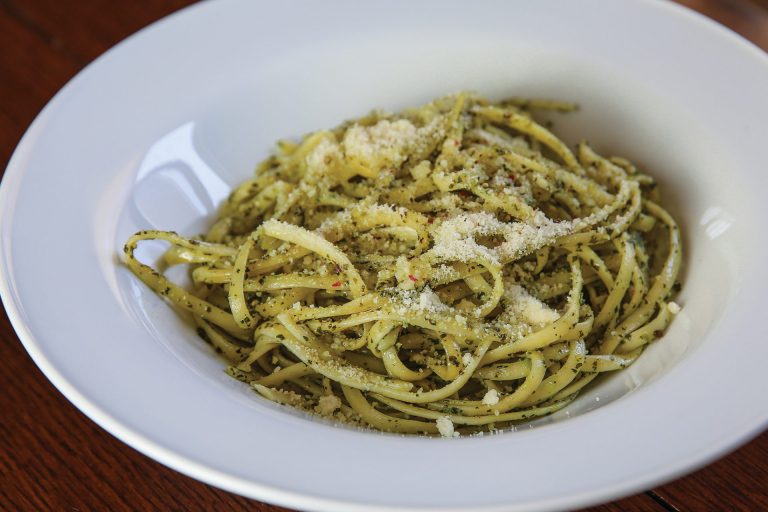
Servings: Makes about 1½ to 2 cups of pesto
Prep Time: 20 minutes
Ingredients:
Ingredients
- 6 cups of young wild garlic mustard leaves, washed and dried
- 3 cloves of garlic
- 1⁄3 cup of shelled pistachio nuts
- 1⁄3 cup of grated Parmesan cheese, plus extra
- 3⁄4 teaspoon of sugar
- Juice of half a lemon
- 3⁄4 to 1 cup of extra virgin olive oil
- Salt and pepper, to taste
Directions
1. If using older garlic mustard plants, trim off woody stems. In a food processor, pulse cloves of garlic, pistachios and grated Parmesan cheese until coarsely crushed. Next, add wild garlic mustard leaves and pulse until you can get the mixture as finely chopped as possible, stopping periodically to push down leaves sticking to the sides.
2. Next, add olive oil in a steady stream while you work the food processor on low, allowing ingredients to emulsify into a paste. Add or detract oil as necessary, depending on how you like the consistency of your pesto. Finally add lemon juice, sugar and season to taste with salt and pepper. Pulse a few times to combine. Store pesto in an airtight container in the refrigerator for up to a week or freeze leftovers for later use.
3. To make pesto pasta, toss pesto with freshly cooked al dente pasta in a pan over low heat until warmed through and fully incorporated. Add cooking liquid from the pasta to thin out the pesto and create a sauce. Season to taste with salt, pepper and lemon juice and/or lemon zest. Sprinkle with plenty of grated or shaved Parmesan cheese on top, and serve immediately.
